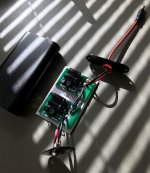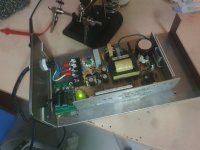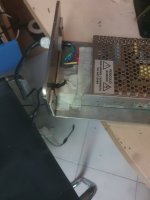Perhaps I expressed myself wrongly, I meant the absence of the diode in the layout posted by wapo54001.The parts list attached to post #1 of this thread, includes (this component) . The word "diode" seems to more closely match the manufacturer's description of this component, than it matches the description of any other component in the post #1 list.
Reviewing the page at the link above, I notice entries for DigiKey , Mouser , and others. Available from several different sellers.
If I may answer that -- I use this filter in low voltage, low power, applications like preamps, LDR volume control, etc where I do not expect to experience load- or source-based voltage spikes. I believe that Mark Johnson designed the filter to be more universal and also his designs always appear to very carefully address every conceivable challenge including voltage spikes. So, for low voltage, I omit the suppression device from Mark's design which did not fit my view of the world; I do, however, really value the smoothing his filter delivers for the power supplies I use in my projects. I use his circuit design but change the layout to physically fit into my project. I think you are referring to a design I did for a B1K in the diyaudio store chassis which is a really tight fit -- I am shoehorning the B1K board and a relay board to switch inputs and control output delay & muting plus the Muses volume control with IR remote, plus Mark's filter on each of the three needed voltages (+/- 15 for the volume control, +24 for the B1K & relay board) which I split off in-chassis from a 24V outboard wall-wart.Perhaps I expressed myself wrongly, I meant the absence of the diode in the layout posted by wapo54001.
So, the absence of the "diode" is pure convenience to conserve space in a crowded space where I did not think that it would serve any purpose. I may have erred and it should be there, it's just my choice.
Hope this helps.
Thanks for the feedback, I probably wouldn't have noticed it either if I hadn't put all the parts out beforehand.If I may answer that -- I use this filter in low voltage, low power, applications like preamps, LDR volume control, etc where I do not expect to experience load- or source-based voltage spikes. I believe that Mark Johnson designed the filter to be more universal and also his designs always appear to very carefully address every conceivable challenge including voltage spikes. So, for low voltage, I omit the suppression device from Mark's design which did not fit my view of the world; I do, however, really value the smoothing his filter delivers for the power supplies I use in my projects. I use his circuit design but change the layout to physically fit into my project. I think you are referring to a design I did for a B1K in the diyaudio store chassis which is a really tight fit -- I am shoehorning the B1K board and a relay board to switch inputs and control output delay & muting plus the Muses volume control with IR remote, plus Mark's filter on each of the three needed voltages (+/- 15 for the volume control, +24 for the B1K & relay board) which I split off in-chassis from a 24V outboard wall-wart.
So, the absence of the "diode" is pure convenience to conserve space in a crowded space where I did not think that it would serve any purpose. I may have erred and it should be there, it's just my choice.
Hope this helps.
Thanks for the info, I just soldered the diode across it.The specified TVS is unidirectional, which is beneficial and underappreciated. I'd never leave it out, myself.
Why [was the TVS diode omitted from the] onboard filter on your Racam Mark? Always pondered this question!
I couldn't figure out a good way to fit it on the PCB, while also maintaining very wide spacing between parts (for extreme noob builders). Have a look at the PCB layout (photo link) -- the filter components take up almost an entire quadrant of the RACAM board, at top right. Something had to be thrown overboard.
You seem to have fun: enjoy it very much!
+1 on Jim, defo worth experimenting.
I played with anything from 0 to 4 daisy chained filters and the results depended very much on the devices I plugged them to.
As already posted, I have yet to find a HIFI device that is within the specs of Mark's filter re current and voltage requirements, fed by an SMPS (regardless its quality), that doesn't benefit from the filter(s). Worst case, seldom, the filter doesn't bring any real plus; in most (many) cases the filter(s) shine, be it 1 or sometimes 2 daisy chained.
Note that Mark's original filter is in itself in fact already composed of 2 "simple" daisy chained filters, and hence one of Mark's filters is already very efficient.
I still have some filters handy to play with at mine, and always 2 additional spares to bring them to friends so we can experiment at theirs together (enabling daisy chaining, or even 1 per channel PS supply, or whatever if more devices are fed by SMPS etc.)
Have fun experimenting with this little jewel!
Claude
+1 on Jim, defo worth experimenting.
I played with anything from 0 to 4 daisy chained filters and the results depended very much on the devices I plugged them to.
As already posted, I have yet to find a HIFI device that is within the specs of Mark's filter re current and voltage requirements, fed by an SMPS (regardless its quality), that doesn't benefit from the filter(s). Worst case, seldom, the filter doesn't bring any real plus; in most (many) cases the filter(s) shine, be it 1 or sometimes 2 daisy chained.
Note that Mark's original filter is in itself in fact already composed of 2 "simple" daisy chained filters, and hence one of Mark's filters is already very efficient.
I still have some filters handy to play with at mine, and always 2 additional spares to bring them to friends so we can experiment at theirs together (enabling daisy chaining, or even 1 per channel PS supply, or whatever if more devices are fed by SMPS etc.)
Have fun experimenting with this little jewel!
Claude
I've had a single one cobbled together on my ACP+ for awhile. A test drive while deciding what kind of enclosure I wanted to put them in. It seemed to elevate the SQ. Had not tried two in series yet. The proper amount of kill is....."over"??😄. Thought I would share a pic just before final assembly of this new dual version. I'm happy with how it turned out. I have pcb's coming (a bunch), and parts waiting in my Mouser cart to build some more to have on hand, give away, or whatever..
I have some boards on offer if there's any interest (price is good, free!). Maybe I'm too late to the game, haven't had many takers.. PO89ZB PCBs
The Amazon dominated of misinformation advertising is leaving me very frustrated and need some aspirin or sound advice... vent is over.
I am looking to find a sleeved, two pair, silicon insulated, flexible copper cable, and recommended AWG to use on my SMPS DC Filter P089ZB Kit.
Or importantly... If you know or have cable that you found both economical and effective, please let me now what to purchase.
I am looking to find a sleeved, two pair, silicon insulated, flexible copper cable, and recommended AWG to use on my SMPS DC Filter P089ZB Kit.
Or importantly... If you know or have cable that you found both economical and effective, please let me now what to purchase.
If you don’t want Amazon, eBay and Aliexpress have these available from multiple sellers. I haven’t ordered this product, but it seems ok. 2 or 4 conductors at 1mm (~18 AWG) should work.
https://www.ebay.com/itm/233961735682
https://www.aliexpress.us/item/2255800912372002.html
I’ve been happy with this brand’s silicone cable before. You could decide on your own sleeving.
https://www.amazon.com/BNTECHGO-Flexible-Conductor-Resistant-Extension/dp/B0779QRR58
https://www.ebay.com/itm/233961735682
https://www.aliexpress.us/item/2255800912372002.html
I’ve been happy with this brand’s silicone cable before. You could decide on your own sleeving.
https://www.amazon.com/BNTECHGO-Flexible-Conductor-Resistant-Extension/dp/B0779QRR58
Last edited:
Try this search engine query and see if you're pleased. The " -amazon " flag instructs the engine to ignore search hits that include the word amazon . . . . . except of course for the "Sponsored" (paid advertisements) links, which you can scroll past very quickly.
The cables from Jameco Electronics, just up the road from me in Belmont, California, look very nice and moderately priced.
_
The cables from Jameco Electronics, just up the road from me in Belmont, California, look very nice and moderately priced.
_
Attachments
- Home
- Source & Line
- Analog Line Level
- PO89ZB, an inline DC filter for SMPS wall warts. Preamps, HPA, Korg NuTube, etc




